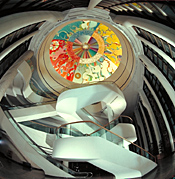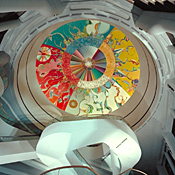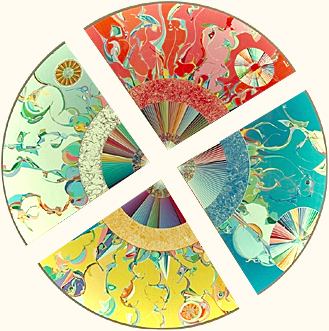
Morning Star
   |
View the new Morning Star – Gambeh Then’ Interpretive Platform. At the river end of the Grand Hall of the Canadian Museum of Civilization is a dome rising seven stories above the granite floor. Nineteen metres (62 feet) in diameter, the dome is adorned with the striking abstract painting Morning Star, the work of Dene Suline artist Alex Janvier. With the assistance of his son Dean, Janvier began painting in June 1993 and finished in September the same year. Morning Star covers 418 square metres (4,500 square feet). Prior to the first brush stroke being applied to the dome, the ceiling surface had to be prepared. Taking a full month, preparation entailed washing the surface, applying a sealer and then coating it with gesso. Following this, progressive coats of sealer and white primer (9 coats in total) were applied until the surface was suitable for the artist to paint his design. After Morning Star was completed, a coat of UV-rated sealer was applied over the entire painting and finally, a matte finish was added to eliminate glare. The title Morning Star refers to the morning star as a guide or a means of finding direction. Janvier explains: "My people had used the morning star as a guide light in the early mornings of the winter hours. They would leave camp... maybe 4 o'clock in the morning and head in some direction... According to the stars in the sky, and especially that one, they pretty well have an idea the direction that they are going to." Janvier similarly views his painting as a guiding light. Features included in the painting reflect common aboriginal values and philosophies. The circle motif represents the circle of life: spiritual and physical, human and natural. Human life, for example, is believed to make a complete circle; a person dies and then life starts again. Likewise, the colours used are meaningful. Among the Chipewyan for example, white, yellow, blue and red are significant colours, seen more frequently than others. Among Native groups generally, these colours are often seen in regalia. In addition, the creation of four distinct areas of colour is important. The number four is significant for Native Peoples: 4 seasons, 4 cardinal points, 4 directions. Janvier refers to these as "natural indicators". The painting is a commentary on the clash of cultures that took place after Europeans arrived in North America and encountered Native peoples. This is one of the major themes addressed in the Museum's permanent exhibitions. The white central circle represents the morning star, the source of all creation. The geometric lines of colour radiating out from the centre (similar to the porcupine quillwork traditionally used by the Dene to decorate clothing and other objects) represent the various aboriginal cultures; each is a separate colour yet, when viewed together, they have the appearance of unity. That ring, representing the Native value system, is juxtaposed with a ring of more organic forms, representing the appearance of European ideas and beliefs. The juxtaposition of geometric and organic symbolizes the struggle between the two value systems. Each of the four distinct areas of colour in the outside ring represents a period in Native history. In the yellow quadrant, a balance of colour and shape reflects a time when the First Peoples were in harmony with nature, with the Great Spirit, and with each other. However, also represented in this yellow area is the arrival of Columbus in 1492, which changed the world of the First Peoples forever. In the blue quadrant, a lack of decoration signifies the weakness of Native culture, overwhelmed by European culture. According to Janvier, the more Christianized Native people became, the more they turned to organic, flowing designs and the less they produced geometric designs. The red quadrant depicts a time of revival and a new optimism. Struggle and disenchantment give way to a new determination on the part of First Peoples to take charge of their own future. The last quadrant, white to link back to the white centre of Morning Star, portrays healing, renewed self-respect, reconciliation and restructuring - a return to a state of harmony. It represents the period following the point at which Janvier created Morning Star. Of Morning Star, and of his work in general, Janvier has said, "I am painting and I am also telling the story of the way things happened to me and to my tribe and to my people and it's a true story." Morning Star was a gift of Ralph and Roz Halbert of Toronto, Ontario, to the people of Canada. About the ArtistBorn in 1935 on Le Goff Reserve near Cold Lake, Alberta, Alex Janvier was raised in the Chipewyan tradition, speaking the Dene language until attending the Blue Quill Residential Indian School when he was eight years old. Following high school, Janvier attended the Alberta College of Art in Calgary, where he first experimented with modernist abstractions. Although he achieved some personal and critical success in the early 1960s, it was not until 1971 that he devoted himself to his art on a full-time basis. During the late 1970s and early 1980s, Janvier's works involved a critical assessment of European influences and alienating experiences that had weakened his spiritual self. Increasingly, his paintings addressed issues related to the concerns of aboriginal peoples. Janvier's paintings are sought after by prominent art collectors and included in many exhibitions of Native art. The Canadian Museum of Civilization is home to one of his major works The Seasons. His abstract style is particularly suited to large-scale works. He completed many murals. Among them is the one in the Muttart Conservatory in Edmonton and another in the Indians of Canada pavilion at Expo '67. Since the late 1980s, aboriginal peoples throughout Canada entered into an era of heightened political awareness and activism. Outstanding land claims, environmental destruction, abuse within the residential school system, Elijah Harper and the Meech Lake Accord, and the armed standoff by Mohawk people at Oka have greatly affected Native communities. Janvier is at the forefront of this new politicism, providing visual commentary on contemporary situations. Janvier is hopeful about the future of aboriginal culture and art, noting that many people are recovering traditional values and practices. According to Janvier, belief in Mother Earth and the Great Spirit is the basis upon which future generations can reclaim true spirituality and freedom as aboriginal people. "Janvier's calligraphic lines are always in motion, recalling natural phenomena like the motion of branches in the wind. The symbolism he ascribes to color is that of the Dene. And his compositions which often flow outward from the centre in four directions, refer to the four cardinal points of the native cosmos, the points of the compass, and the seasons." Nancy Tousley, art critic, Calgary Herald |

